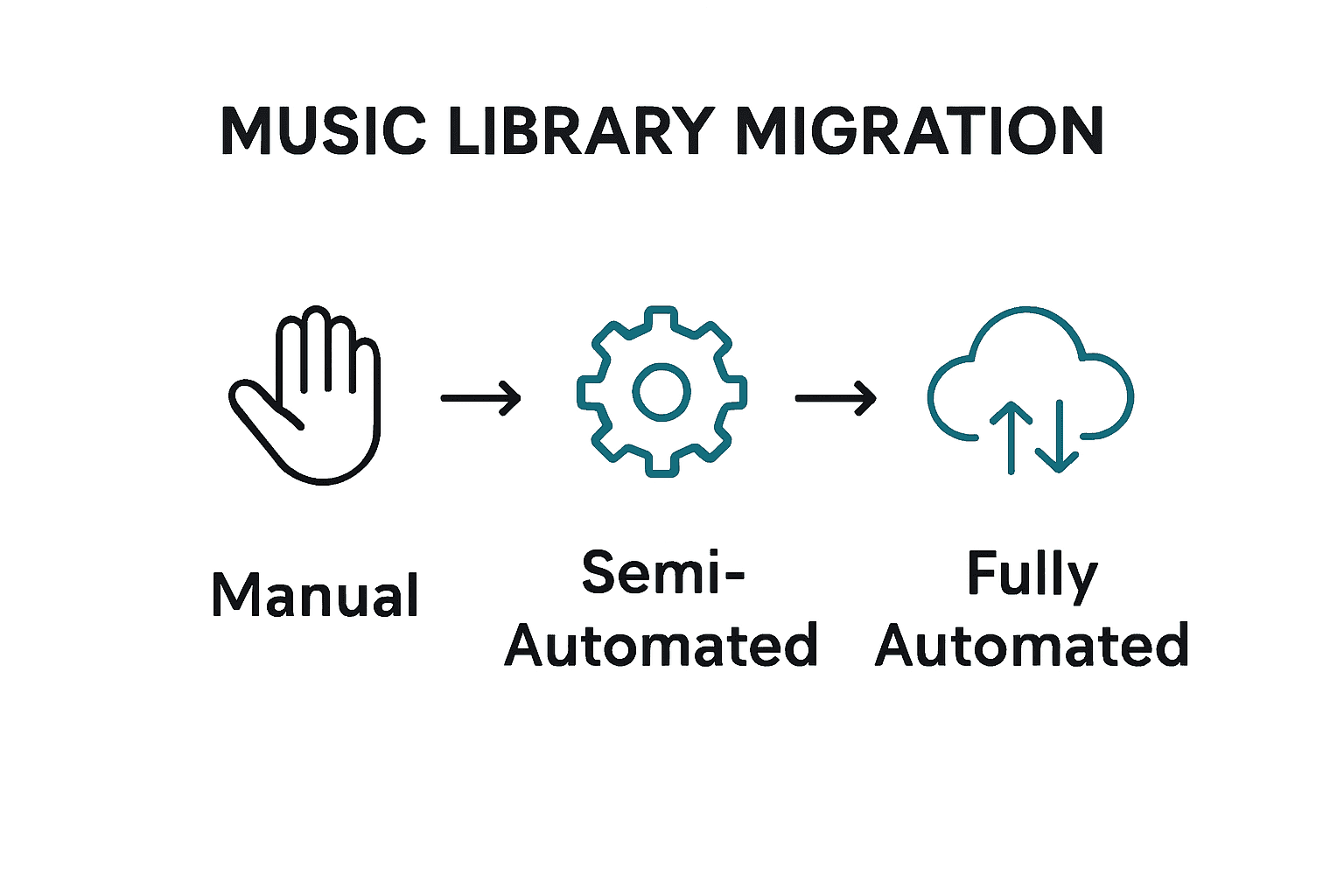Nearly one-third of users report losing valuable playlists or song details when moving their music libraries to a new platform. As streaming services and digital storage options evolve, keeping collections intact through every move becomes a top priority for music lovers. Understanding music collection migration workflows helps you protect your playlists, preserve every bit of metadata, and enjoy uninterrupted listening across any service.
Table of Contents
- Defining Music Collection Migration Workflow
- Types of Playlist and Library Migration
- Step-By-Step Playlist Transfer Process
- Ensuring Song Accuracy and Data Security
- Common Pitfalls and How to Avoid Them
Key Takeaways
| Point | Details |
|---|---|
| Pre-Migration Strategy | Analyze your current music library and evaluate platform compatibility to ensure a smooth transfer. |
| Transfer Method Selection | Choose between manual, semi-automated, or fully automated migration strategies based on your collection size and technical comfort. |
| Data Integrity Focus | Implement rigorous checks for metadata accuracy and secure transfer protocols to maintain the authenticity of your music collection. |
| Anticipate Challenges | Be aware of potential pitfalls such as metadata misalignment and platform compatibility to mitigate risks during migration. |
Defining Music Collection Migration Workflow
A music collection migration workflow represents a systematic approach for transferring musical libraries, playlists, and associated metadata between different streaming platforms or digital storage systems. According to research from MDPI, digital asset migrations require carefully staged processes that ensure comprehensive and accurate transfer of musical collections.
The core components of an effective music collection migration workflow typically involve several strategic phases:
- Pre-Migration Assessment: Analyzing current music library structure, total number of tracks, playlist compositions, and metadata complexity
- Platform Compatibility Evaluation: Determining technical compatibility between source and destination platforms
- Transfer Methodology Selection: Choosing between manual, semi-automated, or fully automated migration strategies
- Data Preservation Verification: Ensuring playlist order, song metadata, and collection integrity remain intact during transfer
As detailed by DLib, successful digital asset migrations require meticulous planning and understanding of potential technical challenges. Professionals recommend creating backup copies of your music collection before initiating any transfer process, which helps mitigate potential data loss risks.
Critical considerations in music collection migration include managing potential metadata discrepancies, handling platform-specific features like custom playlists or algorithmic recommendations, and maintaining the original musical library's organizational structure. By developing a structured workflow, music enthusiasts can seamlessly transition their collections while preserving their carefully curated musical experiences. For additional insights into streamlining your music library transfer, check out our music collection transfer steps guide.
Types of Playlist and Library Migration
Music collection migration encompasses several distinct transfer strategies that cater to different user needs and technical capabilities. Indiana Libraries Guide identifies multiple approaches for transitioning music libraries between platforms, ranging from manual transfers to sophisticated automated solutions.
The primary types of music collection migration include:
- Manual Migration
- Individually selecting and re-adding tracks
- Suitable for small collections
- Time-consuming but offers maximum control
- No additional software required
- Semi-Automated Migration
- Partial automation through platform-specific tools
- Limited transfer capabilities
- Some metadata preservation
- Moderate user intervention needed
- Fully Automated Migration
- Complete transfer using third-party migration services
- Bulk transfer of entire music libraries
- Preserves playlist structures and metadata
- Minimal user intervention
According to School Disco Handbook, successful migration depends on understanding platform-specific limitations and choosing an appropriate transfer method. Each approach presents unique advantages and potential challenges.


Professionals recommend evaluating your specific music collection size, complexity, and technical comfort level when selecting a migration strategy. For those seeking comprehensive guidance on seamlessly transferring playlists, our understanding benefits of playlist migration article provides additional insights into navigating these complex transfer processes.
Step-By-Step Playlist Transfer Process
Transferring music playlists between different streaming platforms requires a systematic and strategic approach. Indiana Libraries Guide outlines a comprehensive methodology for successfully migrating musical collections across various digital environments.
The detailed playlist transfer process involves multiple critical stages:
- Pre-Transfer Preparation
- Create a complete backup of your existing music library
- Verify account credentials for source and destination platforms
- Check compatibility between music streaming services
- Document total number of tracks and playlists
- Initial Platform Connection
- Select appropriate migration tool or service
- Authenticate accounts for both source and destination platforms
- Grant necessary permissions for data transfer
- Review potential metadata transfer limitations
- Playlist Selection and Mapping
- Choose specific playlists for migration
- Identify potential track matching challenges
- Prepare for manual intervention if needed
- Confirm transfer preferences (order preservation, metadata retention)
According to School Disco Handbook, successful playlist transfers depend on understanding platform-specific constraints and maintaining meticulous attention to detail during the migration process. Each streaming service has unique metadata structures and transfer protocols that require careful navigation.
Professionals recommend performing a test transfer with a small playlist first to identify potential synchronization issues. For users seeking more detailed guidance on optimizing their playlist migration experience, our understanding playlist transfer best practices article provides additional in-depth insights into navigating complex music library transitions.
Ensuring Song Accuracy and Data Security
Music collection migration demands rigorous attention to data integrity and security throughout the transfer process. ArXiv Research highlights the critical importance of developing a scalable metadata layer that preserves the authenticity and accuracy of musical information during digital transitions.
Key strategies for maintaining song accuracy include:
-
Metadata Verification
-
Cross-reference track details across platforms
-
Check song duration, artist information, and album metadata
-
Identify and resolve potential discrepancies before transfer
-
Preserve original song attributes
-
Data Security Protocols
-
Encrypt account credentials during transfer
-
Use secure, authenticated migration tools
-
Limit third-party access to music libraries
-
Implement two-factor authentication
-
Create local backups of music collections
-
Matching Algorithm Precision
-
Utilize advanced track matching technologies
-
Handle variations in song titles and artist names
-
Account for regional music catalog differences
-
Minimize manual intervention requirements
According to MDPI Research, successful data migration relies on comprehensive quality control measures that systematically validate each transferred track's integrity. Professional music collection managers understand that seemingly minor metadata inconsistencies can significantly disrupt the listening experience.
Users seeking comprehensive protection for their musical libraries should implement multi-layered verification processes. For additional insights into safeguarding your music collection during migration, explore our guide to playlist security and learn advanced techniques for maintaining your digital music archive's reliability.
Common Pitfalls and How to Avoid Them
Music collection migration is fraught with potential challenges that can derail even the most carefully planned transfer process. DLib Research reveals that most migration failures stem from predictable and preventable issues that users can strategically anticipate and mitigate.
The most significant pitfalls in music collection migration include:
- Metadata Misalignment
- Inconsistent track naming conventions
- Variations in artist name formatting
- Incomplete or incorrect song information
- Regional catalog differences
- Platform Compatibility Challenges
- Unsupported file formats
- Incompatible digital rights management systems
- Restricted library size limitations
- Variations in playlist structure support
- Technical Transfer Complications
- Incomplete playlist transfers
- Loss of custom playlist ordering
- Unexpected track substitutions
- Authentication and permission barriers
According to MDPI Research, successful digital asset migration requires a proactive approach that anticipates potential disruptions and implements comprehensive risk mitigation strategies. Professional music collection managers recognize that seemingly minor technical obstacles can compromise entire music libraries.
To safeguard against these challenges, users must develop a meticulous transfer strategy that prioritizes data integrity and platform compatibility. By understanding potential pitfalls and implementing robust verification processes, music enthusiasts can ensure a smooth and reliable migration experience. For more comprehensive insights into navigating these complex transitions, explore our understanding best practices in playlist migration guide.
Simplify Your Music Collection Migration Today
Migrating your music library can feel overwhelming with challenges like metadata misalignment and platform compatibility issues. This article highlights the importance of a well-structured music collection migration workflow, emphasizing the need for reliable transfer methods that preserve playlist order and song accuracy. If you've struggled with time-consuming manual transfers or concerns about losing your curated playlists, you are not alone.
FreeYourMusic.com offers a powerful, user-friendly platform designed to eliminate these common problems by automating the transfer of playlists across major streaming services such as Spotify, Apple Music, and Amazon Music. With advanced matching algorithms and secure syncing features, you no longer have to worry about metadata discrepancies or data loss. Experience the ease of migrating unlimited playlists with confidence knowing your collections are safe and complete.

Take control of your music library today with FreeYourMusic.com. Discover detailed playlist migration best practices and explore our music collection transfer steps guide to ensure a smooth transition. Start your seamless playlist migration now and enjoy uninterrupted listening on your favorite streaming platforms.
Frequently Asked Questions
What is a music collection migration workflow?
A music collection migration workflow is a structured process for transferring musical libraries, playlists, and associated metadata from one streaming platform or digital storage system to another, ensuring that data is accurately preserved throughout the transfer.
What are the main phases involved in music collection migration?
The main phases include: pre-migration assessment, platform compatibility evaluation, transfer methodology selection, and data preservation verification to ensure a smooth transfer.
What are the different types of migration strategies for music collections?
There are three types of migration strategies: manual migration, semi-automated migration, and fully automated migration, each varying in the level of user control and complexity of the transfer.
How can I ensure the accuracy of my music data during migration?
To ensure accuracy, verify metadata by cross-referencing track details, use secure migration tools to protect data, and implement matching algorithms to handle variations in song titles and artist names.




